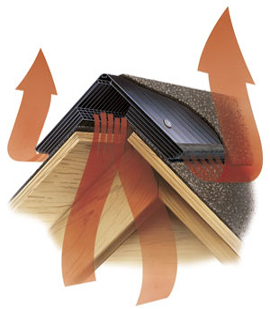
Inadequate or poor attic ventilation can allow mold and mildew to damage your attic insulation, destroy your shingles and plywood roof decking, and significantly increase your energy bills higher then they currently are!
In a properly working attic ventilation system, there is a continual flow of outside air through the attic which helps remove humidity, protecting the insulation, the underside of the roof decking and most importantly is helping lower temperatures in the living space and reducing the load on the homes HVAC system which in turn lowers energy bills for homeowners.
A roof ventilation system consists of a balance of air intake through the vents (at your eaves or soffits) and the air exhausted through mushroom vents or a ridge vent (at the top of your roof ridge) that is found on most newly built homes. The most important part of the roof ventilation system is it must be a balanced ventilation system. So you should never have a greater amount of exhaust ventilation air leaving the home exceed the amount of intake ventilation air entering the home.
The Federal Housing Administration recommends a minimum of at least 1 square foot of attic ventilation (both intake and exhaust) for every 300 square feet of attic space. For example, if your attic is 900 square feet, you need a total of 3 square feet of ventilation. This amount should be divided equally between intake and exhaust ventilation (i.e., 1 1/2 feet of each) to insure proper air flow through the attic space
Is it worth the Risks?
Many homes in the United States do not have adequate proper attic ventilation in their homes. Why, because most property owners do not understand that attic ventilation can affect the lifespan of their entire home if it’s not corrected!
In the summer months
Improperly vented roofing systems can cause heat in the attic heat to build to levels that reach in excess of 160°F. The amount of insulation present in the attic will determine how much of this super-heated air will penetrate the ceiling insulation into the living area below. This increase in temperature will also increase the load that is put on the homes air condition system increasing energy cost to rise.
Additional examples of damage from poor roof ventilation can also include the following:
A properly ventilated attic is essential to help reduce the load on your air conditioner by removing the super-heated air out of your attic before it builds up and causes additional damages to the structure.
In the winter months
Many items within the household help contribute to moisture build up such as, household appliances, bathtubs, showers. In an improperly vented attic the moisture will condense from a vapor to a solid (water droplets) and cling to the underside of the roof decking which can clearly be seen when in the attic. This moisture will cause mold, mildew and wood rot to form on the underside of the roof decking and some of the condensation will fall from the roof decking, soaking and packing the attic insulation and reducing its efficiency. This will eventually become visible in the home with the presence of water stains on the ceiling and increased damage.
Additional structural damage can include:
The obvious conclusion
All attic spaces should be properly ventilated to help prevent the formation ice dams in cold climates. During the winter, ice and snow on a roof will melt and run down the deck to the cooler eaves due to excessive heat from the living space getting into the attic due to poor insulation which also leads to high heating energy cost. This melting snow runs down the roof towards the gutters and can re-freeze if conditions are right, this will create an ice dam that will likely force water back up under the shingles. If this process goes on every season the end result will be that the roof decking will begin to rot and let water leak into your home. This can cause hundreds or thousands of dollars of damage to your ceilings, insulation and walls. The combination of adequate roof ventilation and the proper amount of attic insulation reduces the amount of melting that occurs on your roof. This is accomplished by having your attic well insulated so you can keep the heat in the living spaces instead of it passing through your ceilings into the attic space, and when coupled with proper ventilation the attic temperature will be much cooler thereby reducing the melting snow on the roof and chance that ice dams will form snow melting and the water running down to the gutters and freezing. Controlling ice damming is important to prevent changing the pitch (slope or direction water flows) and from pulling the gutters off the home, due to the excessive weight in the gutters from the ice and icicles hanging from the gutters in worse cases.